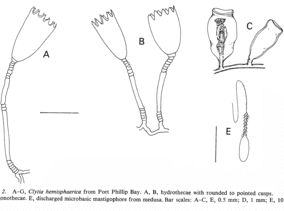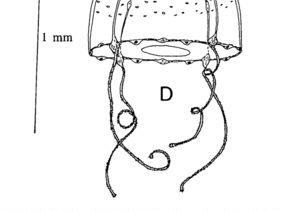You are here
Taxon
Clytia hemisphaerica (Linnaeus, 1767)
Nomenclature
-
Family: CampanulariidaeGenus: Clytia
-
Synonyms: 41
SUMMARY
Hydrorhiza tubular, loosely attached to the substrate.
Stems simple, to 5 mm high, usually unbranched, or sometimes branched once or twice. Perisarc of stems delicate, shining, annulated at the origin and distally below the hydrotheca.
Hydrotheca deep conical, expanding evenly from the base to margin. Margin dentate with 8 - 10 evenly spaced cusps, these variable in shape from sharply pointed to blunt, with wide incisions between.
Hydranth with 12 - 16 filiform tentacles.
Gonothecae borne on the hydrorhiza, barrel-shaped, walls smooth or sometimes slightly undulated, truncated and constricted distally, summit concave Gonotheca containing one to three developing medusae.
Medusa almost hemispherical at liberation, bell rather thick with scattered nematocysts or nematocysts in a band (showing as bright spots) around the mid region. Stomach short, mouth with four poorly defined lips armed with nematocysts. Radial canals narrow with rudimentary gonads situated about the middle. Four tentacles around the margin, each arising from an oval marginal bulb at the base of the radial canal. Adult medusa with about 32 tentacles and measuring up to 20 mm diameter across bell
Colour: Colonies colourless to translucent white. Medusa bell transparent, tentacle bulbs, gonads and stomach pale yellow.



